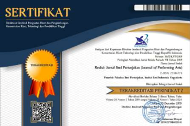Musik Hip-Hop sebagai Bentuk Hybrid Culture dalam Tinjauan Estetika
Abstract
Berbicara mengenai seni mempunyai tendensi berbicara mengenai kehidupan itu sendiri. Dalam kehidupan ini maka proses penciptaan tidak akan pernah stagnan. Dinamisasi dalam kehidupan ini akan menjadikan seni senantiasa untuk mengupayakan dirinya selalu kreatif dalam menciptakan suatu karya seni. Seni yang terlibat dalam kehidupan akan dihasilkan oleh suatu masyarakat yang mampu menangkap esensi seni dalam kehidupan itu sendiri. Seni pada akhirnya merupakan produk masyarakat sebab bagaimanapun juga seni tidak dapat melepaskan dirinya dari suatu masyarakat. Produksi seni yang bersifat kolektif, atau dirasa dan dicipta oleh masyarakat, akan mengutamakan nilai-nilai yang menubuh, mengedepankan etnisitas lokal, dan penuh dengan intepretasi.
Proses penciptaan seni dalam kehidupan manusia tidak dapat dilepaskan pada proses penciptaan kemurniaan dan hibriditas yang merupakan unsur yang mendasar. Proses penciptaan ini secara aktif terlibat dalam akulturasi atau asimilasi kebudayaan. Dilematis menjadi persoalan utama dalam terjadinya proses penciptaan tersebut, “Kemurnian” dan “hibriditas” menjadi gesekan persoalan. Hibriditas, merupakan telaah yang pas dalam melihat pembauran tersebut. Proses hibriditas menjadi semakin menarik terlebih seni yang tercipta dibentuk di masyarakat urban. Seni yang dicipta masyarakat urban menuju pada seni popular, tetapi tidak menutup kemungkinan itu semua berangkat dari masyarakat rural. Habitus, penubuhan, intepretasi individu yang tergabung dalam masyarakat menjadi proses pembentukan yang menarik.
Padatataran ini, estetika hybrid culture menjadi studi mendalam dalam melihat persoalan kemajemukan nilai-nilai pada proses pembentukan seni itu sendiri. Pengarahan penelitian ini akan ditujukan kepada pemahaman atas pembentukan estetika seni pertunjukan, dan melihat korelasi yang terjadi antara nilai-nilai hibriditas pada estetika seni pertunjukan. Hip hop merupakan jenis musik yang mengalami percampuran, pembauran, dan intepretasi ulang atas sebuah kebudayaan. Hibriditas hip hop menjadi hakiki, terlebih bila melihat esksistensi dan konsistensinya kini.
Hip-Hop Music as a Form of Hybrid Culture in the Aesthetics Reviews. Talking about art, it has a tendency to talk about life itself. The process of creation will never be stagnant in life. The dynamism in life will make art as an effort of seeking itself to be actively creative in creating a work of art. The art involving in life will be produced by a society that is able to capture the essence of art in life itself. Art is then ultimately a product of society because art cannot keep itself away from the society. The collective art production, or perceived and created by the community, will give more priority to the increasing values , prioritize the local ethnicity, and be full of interpretation.
The process of creating art in human life cannot be released from the process of creating purity and hybridity which are parts of a fundamental element. The process of creation is actively involved in the acculturation or assimilation of culture. Dilemma becomes the main issue in the process of creation, “purity” and “hybridity” then are the friction of problems. Hybridity, is a suitable study in reviewing such assimilation. The process of hybridity becomes increasingly attractive especially when the created art is formed in the urban society. Art that is created by the urban society leads to the popular art, but it does not rule out the possibility that all arts may derive from the rural community. Habitus, embodiment, and the individual interpretation that belong to the society become theinteresting process of formation.
Keywords
Full Text:
PDFReferences
Artaud, Antonin,. 1970. Theatre and Its Double, trans. Victor Corti. United Kingdom: Calder
& Boyars Ltd.
Bhaba, Homi. K. 2007. The Location of Culture. Cetakan ke-5. London: Routledge.
Burke, J.P. 2009. Identity Theory, Oxford: Oxford University Press.
Bourdieu, Pierre.1977. Outline of a Theory of Practice. Cambridge: Cambridge University
Press.
Bourdieu, Pierre.1990. The Logic of Practice, trans by Richard Nice. Stanford: Stanford
University Press.
Bourdieu, Pierre. 1994. Distinction: a social critique of the judgment of taste. London:
Routledge.
Clark, Jude. 2003. Introduction: Urban Culture: Representations and Experiences in/of Urban Space and Culture. Agenda, No. 57, Urban Culture (2003), pp. 3-10.
Goldberg, Roselee,. 1988. Performance Art from Futurism to the Present. London: Thames & Hudson.
Huxley, Michael & Noel Witts. 1968. The Twentieth-Century Performance Reader.
London: Routledge.
Hauser, Arnold. 1982. The Sociology of Art, terj.Kenneth J. Northcott. London: University of
Chicago Press.
Jenkins, Richard. 1990. “Dimensions of Adulthood in Britain: Long term Unemployment and mental handicap” in P. Spencer (ed.) Anthropology and the Dirddle of The Sphinx: Paradoxes of Change in the Life Course. London: Routledge.
Jenkins, Richard. 1992. Pierre Bourdieu “Key Sociologists”. London: Routledge.
Jenkins, Richard . 2013. Membaca pikiran Pierre Bourdieu, terj., Nurhadi. Bantul: Kreasi wacana
Kayam, Umar. 1981. Seni, Tradisi dan Masyarakat. Jakarta: Sinar Harapan.
Koentjaraningrat, 1994. Kebudayaan Jawa. Jakarta: Balai Pustaka.
Lockard, Craig A. 1998. Dance of Life, Popular Music, and Pokitics in Southeast Asia. Honolulu: University of Hawai’I Press.
Lynch, Gordon. 2005. Understanding Theology and Popular Culture. Victoria: Blackwell
Prasetya, Hanggar Budi; Timbul Haryono; Lono L. Simatupang. 2011. Habitus, Ngêng, dan Estetika Bunyi Mlèsèt dan Nggandhul pada Karawitan. Paradigma Jurnal Kajian Budaya. Vol 1, No. 2 (2011)
Poerwadarminta, W.J.S. 1939. BAOESASTRA DJAWA. Batavia: J.B. Walter Uitgevers –
Maatschappij n.v. Groningen.
Richter, Max M. 2012. Musical Worlds in Yogyakarta. Leiden: KITLV Press.
Selo Sumardjan. 1980.“Kesenian dalam Perubahan Kebudayaan” dalam Analisis Kebudayaan, tahun 1 no.2.
Shuker, Roy. 1994. Understanding Popular Music. New York: Routledge.
Spreadley, James P. 2007. Metode Etnografi. Terj Misbah Zulfa Elizabeth. Yogyakarta: PT. Tiara Wacana.
Sumardjo, Jakob. 2010. Estetika Paradoks. Bandung: Sunan Ambu Press.
Turner, K. 1984. Mass Media and Popular Culture. Chicago: Science Research Association
Usman, Sunyoto. 2000. “Apresiasi Masyarakat Terhadap Musik Populer” dalam Ahimsa-Putra (ed). Ketika Orang Jawa Nyeni. Yogyakarta: Galang Press.
Weirtheim, W.F.1964. Indonesian Society In Transition. A Study of Social Change. The Hague: W. ban Hoewe.
Young, Robert J.C. 1995. Hybridity in Theory Culture and Race. London: Routledge
DOI: https://doi.org/10.24821/resital.v16i2.1507
Refbacks
- There are currently no refbacks.
This work is licensed under a Creative Commons Attribution 4.0 International License.



